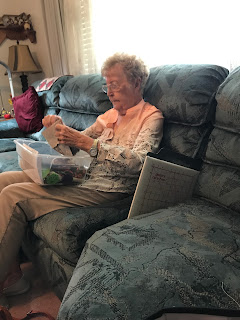Margaret Burt - 1814 - 1874. Information taken from history found on FamilySearch, author unknown, and a history by Margaret H. Burt Tensmeyer written 20 Aug 1964.
Margaret was born in Dunfermline, Fife, Scotland, a daughter of Ann Allen and Peter Burt. Her family worked in the coalmines. She gave birth to fourteen children, six of whom died before the family immigrated to America. Margaret Tensmeyer states: "The condition portrayed in the show "How Green Is My Valley" [this is one of my favorite books, maybe I was drawn to it because of the connection] were very similar to the stories my father John Burt Jr. told about his experiences in the mines when he was a lad. Women carried coal in baskets or creels, as they were called, their faces streaked with dust and sweat. Horror gripped them at the sound of the disaster whistle, for those at home as well as the workmen."
It is believed that she joined the church near the same time as her husband, John Burt, 19 July 1847. Fifteen years later they would say good-bye and John would leave his wife and smaller children as he and his older daughter immigrated with a plan to send money for the remainder of the family to come to Utah.
About two years later, with the help of the Perpetual Emigration Fund (it was hard for either group to raise the money as wages in Utah were paid in provisions, clothing and exchange of work), they left London on the ship "Hudson" on the third day of June 1864. Margaret and her five younger children were in the John McKay Company.
Crossing the ocean, measles broke out. Many adults died of it. Margaret's family was blessed that they had no casualties. Arriving in New York, 18 July 1864, they had spent 46 days on the water. Soon after noon on the 21st they boarded a train leaving for the west. At Buffalo a change of trains was made and they were made to ride in cattle cars that were not clean. They came to learn that the land trip was more dangerous than the ocean voyage. At times the train was boarded by Army men looking for deserters.
Along the way many bridges had been torn, washed out and sometimes burned. It was then expected of them to carry all the baggage across the streams. They had to walk long distances at times. While staying at a railway station after crossing the Mississippi River, a great storm arose and they sought some protection by the river. "While there, some wicked men tried to drown them in the river." (Tensmeyer) They again boarded cattle cars and at St. Louis all were placed on a river boat which carried them to Wyoming, Nebraska. Here was the gathering place for the Saints to prepare for the trip west. A large church house was the only building and was used as a storehouse for the Perpetual Emigration Fund under the leadership of Elder Erastus Snow. Teams and supplies were sent from Utah.
They were assigned to the Warren S. Snow Company. They camped at Ft Kearney. During the journey there were bad storms and snow came early. Buffalo chips were used along the way for fuel. Adults were buried along the way.
John Burt Jr. said that they entered the valley in a blinding snow storm and that they were cold, wet and hungry. Because they were so late entering the valley the companies were given a special reception. Saints came with hot soup, beef, potatoes, pies, tea, coffee and sugar and the sick were cared for and those that had no home were taken into homes of the Saints.
Tensmeyer states, "Grandmother Margaret Burt Burt [her husband was a second cousin] was rather a large woman, strong in mind and body. She had worked in the mines even when her fourteen children were being raised, staying at home only long enough to be confined, then she was required to take her place with the other able bodied women in carrying coal in baskets or creels, as they were called, for only a few cents a day." John Burt Jr tells that his mother Margaret had long dark hair. She had developed heart trouble and was ill for a long time. "He stated that she was so lovable and kind, yet if she set her mind to accomplish anything even when time and odds were against her that task was completed." (Tensmeyer)
This was the ultimate road trip. I've crossed the US via automobile five times - Utah to Boston, Utah to North Carolina and back, Utah to Virginia and back - with some adventures along the way. I don't know how the immigrants did it as I complain about the size or softness of the beds. They were strong people. The women, though we sometimes think of them as weak, dependent or incapable, were anything but. They worked hard providing for their families, often times without a spouse's help, they knew great sorrow, and I hope they experienced great joy. They have left me a legacy that I know I am unable to duplicate.














%201894%20passenger%20list.jpg)



